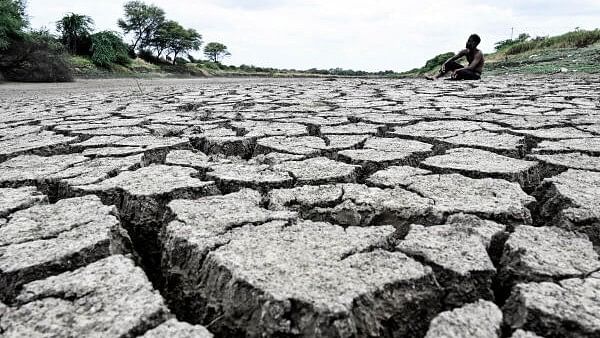
View of cracked ground after river water has dried up in Karnataka.
Credit: Prajavani Photo
As many as 195 taluks, or three-fourths of Karnataka, will be declared as drought-hit, the Cabinet sub-committee on disaster management decided on Wednesday.
The list of drought-hit taluks will be released after Chief Minister Siddaramaiah signs off on it.
“It has been decided to recommend to the CM declaring 195 taluks as drought-hit,” Revenue Minister Krishna Byre Gowda, who heads the Cabinet sub-committee, said.
Karnataka has 236 taluks in 31 districts.
As per the union government’s guidelines, Karnataka has 161 taluks suffering from severe drought, Gowda said. “Another 34 taluks have moderate drought. Under the guidelines, ‘moderate drought’ is a separate category. The union government may or may not provide grants to taluks under this category. However, farmers are in distress and their crops are getting destroyed. So, we’ve decided to recommend declaring as drought-hit even these 34 taluks,” Gowda explained.
A memorandum to the union government will be prepared in the next 7-10 days.
“Once drought is declared, task forces will be constituted in the affected taluks. Funds will be provided to arrange tankers and rent borewells to supply drinking water,” Gowda said. “Farmers will be given free fodder and seeds for which Rs 20 crore has been sanctioned,” he added.
Deputy commissioners have Rs 492 crore that they can use for drinking water supply. “We (government) also have Rs 400 crore ready,” Gowda said.
Rural Development Minister Priyank Kharge said the drinking water problem is not extreme as of now. “My department is giving Rs 1 crore to every zilla panchayat. Under the contingency plan, Rs 7 crore has been released,” he said.
In the drought-hit taluks, the number of person-days under the Mahatma Gandhi National Rural Employment Guarantee Act will increase from 100 to 150.
Contradictory reports
There are 40 taluks facing rain deficit, but the government is not able to declare them as drought-hit, Gowda said. “In these 40 taluks, when we look at satellite imagery, there’s green cover or vegetative growth and moisture distress isn’t seen. These are mandatory requirements under the guidelines. So, we can’t declare them as drought-hit despite the rain deficit,” he explained.
“While there’s vegetative growth and no moisture distress, the crop situation on the ground is disappointing. We have these contradictory reports. We want to scientifically analyse this,” Gowda said.
So, the Cabinet sub-committee has asked the state’s four agricultural universities and one horticulture university to study this and submit a report in 10 days.
